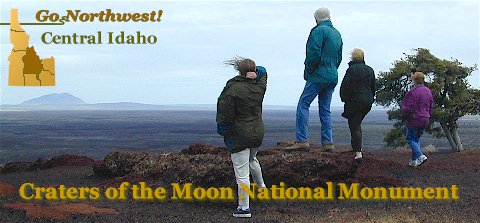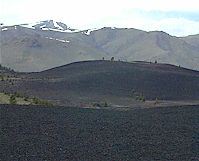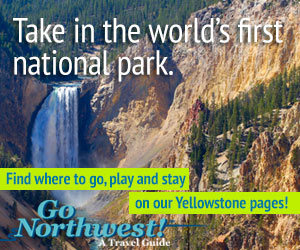More Craters of the Moon
Highlights
Cool Facts
Facilities
Getting There
When to Visit
Web Sites
More Central Idaho
Challis
Bellevue
Hailey
Ketchum
Salmon
Stanley
Sun Valley
Idaho Travel Regions and Maps
Map
Central
Map
Eastern
Map
North Idaho
Map
North Central
Map
South Central
Map
Southeast
Map
Southwest
Central Idaho Attractions
Craters of the Moon National Monument
Desolate, difficult lava fields punctuated by cinder cones rising to 700 feet and more give this barren landscape its apt name, "Craters of the Moon". Protected as a national monument, this harsh, "prickly" landscape is one that at first glance seem so well armored as to have no need for human protection. The casing of basaltic formations does not invite plough or tire. Pioneers despaired over the place, and miners found nothing to entice them. From personal experience, I can tell you the eroded basalt rock whisked about by the wind is akin to ground glass; it is hard on the lungs and within minutes will get into shoes and ruin stockings.

Of course, on second glance the uniqueness of this landscape is well worth preserving for future generations. Robert Limbert and W. L. Cole, who were instrumental in having the area declared a Monument in 1924, appreciated this. They became advocates for the area, despite a trek through this lunar landscape that lacerated their boots, as well as the paws of their faithful four-footed companion whom they had to carry most of the way.
 Craters
of the Moon is situated at the northern end of the 60-mile long Great Rift
Zone on the Snake River Plain. The rift zone is basically a series of big
cracks in the ground, out of which lava flows began about 15,000 years ago,
until about 2,000 years ago. (There is no volcano as such.) The most recent
activity was in the Monument's part of the rift zone. The rift is due for
another extrusion of lava within the next thousand years. Scientists
theorize that what's caused the plain, the rift and the Craters area is a
"hot spot" beneath the earth's crust. As the North American continental
plate floats past over it, that part of the crust gets melted (the plain),
opens up (the rift) and gets erupted upon (the lava formations). Yellowstone
National Park is where the hot spot is believed to currently be. The
Monument also encompasses the foothills of the Pioneer Mountains (see photo
above), and it is fascinating to see how the lava has flowed into their
folds.
Craters
of the Moon is situated at the northern end of the 60-mile long Great Rift
Zone on the Snake River Plain. The rift zone is basically a series of big
cracks in the ground, out of which lava flows began about 15,000 years ago,
until about 2,000 years ago. (There is no volcano as such.) The most recent
activity was in the Monument's part of the rift zone. The rift is due for
another extrusion of lava within the next thousand years. Scientists
theorize that what's caused the plain, the rift and the Craters area is a
"hot spot" beneath the earth's crust. As the North American continental
plate floats past over it, that part of the crust gets melted (the plain),
opens up (the rift) and gets erupted upon (the lava formations). Yellowstone
National Park is where the hot spot is believed to currently be. The
Monument also encompasses the foothills of the Pioneer Mountains (see photo
above), and it is fascinating to see how the lava has flowed into their
folds.
Read on about Crater's highlights...
|
Weather |
Click on the town and road map above to locate cities, towns, attractions and points of interest. |
Go Northwest!
Bookstore
Best selection of books on the Northwest.
Click here!
 Craters
of the Moon: A Guide to Craters of the Moon National Monument by
Division of Publications National Park Service. Official National Park
Handbook. Part 1 introduces the park and recounts its early
exploration. Part 2 explores how life has adapted to the park's volcanic
landscape and how people have perceived it. Part 3 presents concise travel
guide and reference materials for touring the park and for camping.
Order now...
Craters
of the Moon: A Guide to Craters of the Moon National Monument by
Division of Publications National Park Service. Official National Park
Handbook. Part 1 introduces the park and recounts its early
exploration. Part 2 explores how life has adapted to the park's volcanic
landscape and how people have perceived it. Part 3 presents concise travel
guide and reference materials for touring the park and for camping.
Order now...
 Idaho
Off the Beaten Path: A Guide to Unique Places, 9th Edition by Julie Fanselow.
This guidebook features fun, unusual and different things travelers want to see and experience.
Discover the best in local dining, quirky cultural tidbits, hidden
attractions and unique finds in the Gem State.
Order now...
Idaho
Off the Beaten Path: A Guide to Unique Places, 9th Edition by Julie Fanselow.
This guidebook features fun, unusual and different things travelers want to see and experience.
Discover the best in local dining, quirky cultural tidbits, hidden
attractions and unique finds in the Gem State.
Order now...
 Compass
American Guides: Idaho, 3rd Edition by John Gottberg. The guide that has
it all; spectacular photography, evocative prose, insider tips, and detailed
color maps to help you make the most of your trip. Written by longtime Idaho
residents, this book provides in-depth coverage of the history, culture and
character of one of America's most spectacular destinations!
Order now...
Compass
American Guides: Idaho, 3rd Edition by John Gottberg. The guide that has
it all; spectacular photography, evocative prose, insider tips, and detailed
color maps to help you make the most of your trip. Written by longtime Idaho
residents, this book provides in-depth coverage of the history, culture and
character of one of America's most spectacular destinations!
Order now...
We appreciate your orders. They help keep
Go Northwest! online.
Northwest Books
from . . .
![]()


